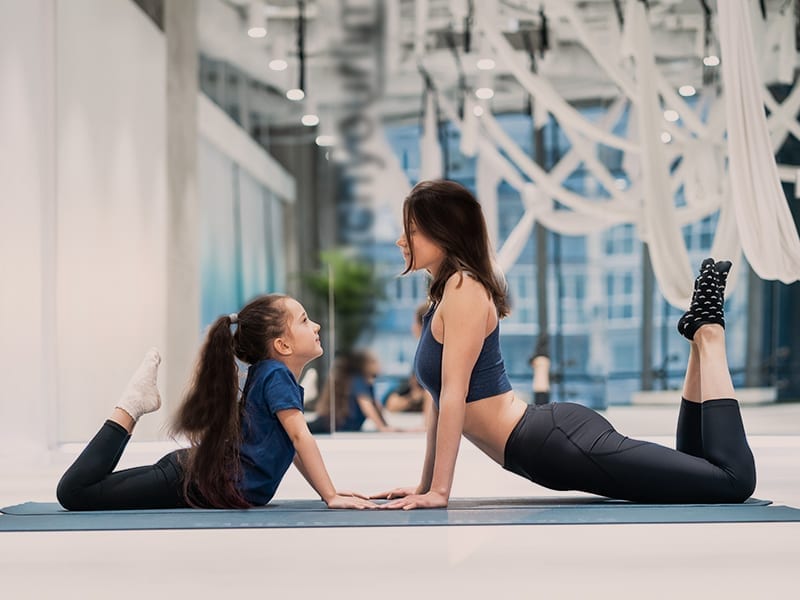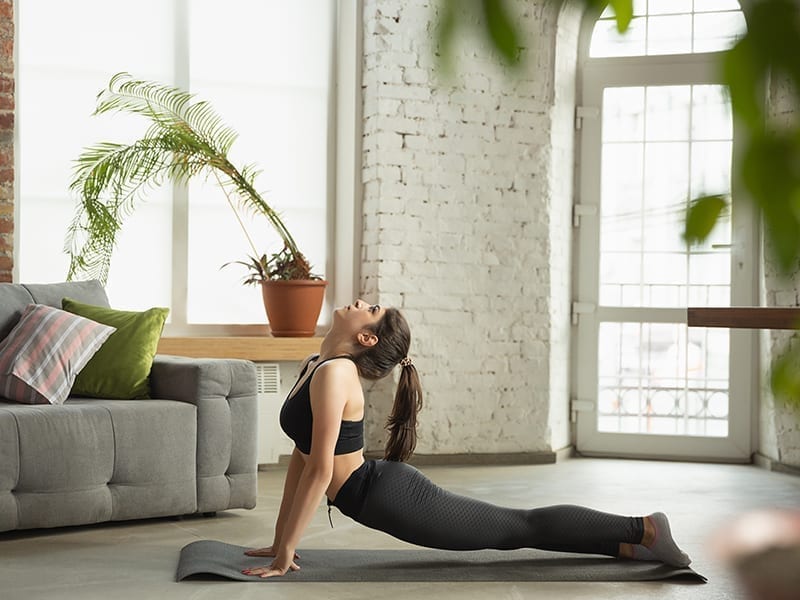Yoga has some unique benefits for each phase of a woman’s life. Post-pregnancy is one of the important phases for a woman, where she is going through lots of physical and emotional changes and challenges. Postnatal yoga can help significantly in women’s recovery from childbirth, on a physical, emotional and spiritual level. Yoga is all about taking time for yourself and understanding your physical and emotional nitty-gritty.
To shed all the baby weight, instead of hitting the gym, yoga is a great way to initiate the healing process. As you can always start slow and at your own pace you can increase the intensity. Always remember, your body has gone through a major change for almost a year and after giving birth, it is still adjusting to getting back to its normal self.
Before starting yoga or any fitness routine it is recommended to wait at least six weeks after childbirth, in case of normal delivery and in case of c-section, then waiting for 12-16 weeks postpartum is recommended. However, it is always better to check with your doctor before starting any postpartum fitness routine.
Benefits Of Postpartum Yoga

1. Build Overall Physical Strength & Stamina
During the 9 months of pregnancy, the whole body goes through a lot of changes and stress. A good yoga regime can make you aware of the body parts where you must focus more. Postnatal yoga can help to restore the strength of the spine, joints and muscles.
2. Regain Core Strength & Tone Abdominal Muscles
Postnatal yoga can help support your body by building core strength and abdominal muscles. Stronger core muscles will also help reduce any back pains that may have developed through pregnancy or postpartum baby care. During birth, the deep abdominal muscles can separate. Yoga can help to tone the abdominal muscles and get them back in shape.
3. Improve Bladder Control
Postpartum leaking urine, the unintentional leaking of urine that many women often experience, usually while laughing, sneezing, coughing, or performing any strenuous activity is common after giving birth. During pregnancy, a growing uterus puts pressure on the pelvic floor and bladder and hence weakened muscles around the bladder and pelvis. Yoga posture along with bandhas like Mulabandha and Uddiana bandha can help in strengthening pelvic floor muscles.
4. Posture Correction
During pregnancy, the core strength is compromised as the muscles stretch to make space for the baby and hence pelvic stability is challenged. Glutes tend to weaken, hip flexors tighten, and the strength of the pelvic floor reduces – all of which leads to bad posture and alignment.
5. Ease Back, Shoulder & Neck Pain
Back pain is a very common problem pre and post-pregnancy. Carrying a baby and breastfeeding makes the shoulders, neck and back stiff. Yoga asanas mainly focused on the shoulder, neck and back can reduce these pains, making breastfeeding easier and helping the body to recover after pregnancy and birth.
6. Maintain Mental and Emotional Balance
Yoga is a great way to restore your hormonal balance, as pregnancy can bring intense hormonal changes in the mother’s body. Post-pregnancy many women go through major emotional turmoil. Incorporating yoga as a daily routine can help in reducing anxiety and depression. It provides rest and instant relaxation. We’ve specially curated a list of yoga poses for hormonal imbalance, do see here!
Postnatal Yoga Asanas for New Moms
1. Balasana (Child Pose)
Benefits:
- Releases tension in the back, shoulders and chest
- Stimulates the abdominal organs
Steps:
- Kneel on the floor. Touch your big toes together and sit on your heels.
- With Exhalation bend forward and touch your head to the floor.
- Stretch your arms towards the front of the yoga mat, palms placed facing down on the mat.
2. Setu Bandhasana (Bridge Pose)
Benefits:
- The shoulder supported or simply bridge, also called Setu Bandhāsana, is an inverted back-bending asana in modern yoga and hatha yoga as an exercise
- It helps in alleviating stress and improves blood circulation
Steps:
- Lie down in a supine position (on your back) and hand beside your body.
- Fold your knees and hold your ankle with your palms.
- The distance between the feet should be hip apart.
- With inhale raise your back up and push your abdomen out.
- Hold this pose for 30 seconds and continue breathing normally.
- With exhalation bring your back down and relax.
3. Marjariasana (Cat Stretch)
Benefits:
- This pose helps relieve stress, increase spinal flexibility and mobility and create emotional balance
- Cat Pose mostly focuses on stretching the lower back, but the movement also stretches the muscles of the hips, upper back, and lungs
Steps:
- Come onto your fours. Your wrist and shoulder must be inline and your hip and knees as well. It should look like a tabletop posture.
- With an exhalation, draw your abdomen in and spine up (round your back out).
- Point the crown of your head to the floor. Don’t force your chin onto your chest.
- With an inhalation, look up and spine down. Repeat it a few times.
4. Gomukhasana (Cow Face Pose)
Benefits:
- Strengthens muscles of ankles, hips, thighs, shoulders, triceps, inner armpits and chest
- Strengthens back muscles
Steps:
- Sit in dandasana (back straight and legs extended in front).
- Bend your right leg and place the right foot under your left hip.
- Bend your left leg and draw it towards your right hip.
- Your left knee must be over your right knee.
- Raise the left arm above your head and bend the elbow. Simultaneously, bring the right arm behind your back and interlock both hands.
- Stay as long as you are comfortable.
- Relax and repeat for the other leg.
5. Viparita Karani (Legs-Up-the-Wall Pose)
Benefits:
- Stretches the back of the neck, front torso, and back of the legs
- Regulates blood flow
- Relieves swollen ankles and varicose veins
Steps:
- Lie down on your back (supine position) with your legs together.
- Raise the legs up keeping them straight.
- Support the lower back with hands, keeping elbows on the floor. Lower body elevated.
- Remain steady for some time.
- Inhale and exhale completely, holding your breath and pumping the stomach.
6. Virabhadrasana II (Warrior II Pose)
Benefits:
- Builds stamina and concentration
- Energises tired limbs
- Stimulates your abdominal organs
Steps:
- Stand straight with your legs by keeping a distance of 3-4 feet between each other.
- Inhale and raise both hands parallel to the ground and turn your head to the right.
- While exhaling slowly turn your right foot 90 degrees to the right.
- Slowly bend your right knee. Keep in mind that the right thigh should be parallel to the ground. Stay in this position for some time. Breathe (inhale) deeply 4 times.
- After this come to your original standing position and breathe normally. And perform the same steps for the left leg by turning the head to the left.
- Repeat this cycle 4-5 times.
7. Baddakonasan (Butterfly Pose)
Benefits:
- This pose helps to calm the mind and improve blood circulation.
Steps:
- Sit on a mat and stretch out your legs.
- Fold your knees and bring your feet to the centre. Then straighten your back.
- Using your palms hold your feet for a few seconds. Release.
- Repeat this about 4 times.

